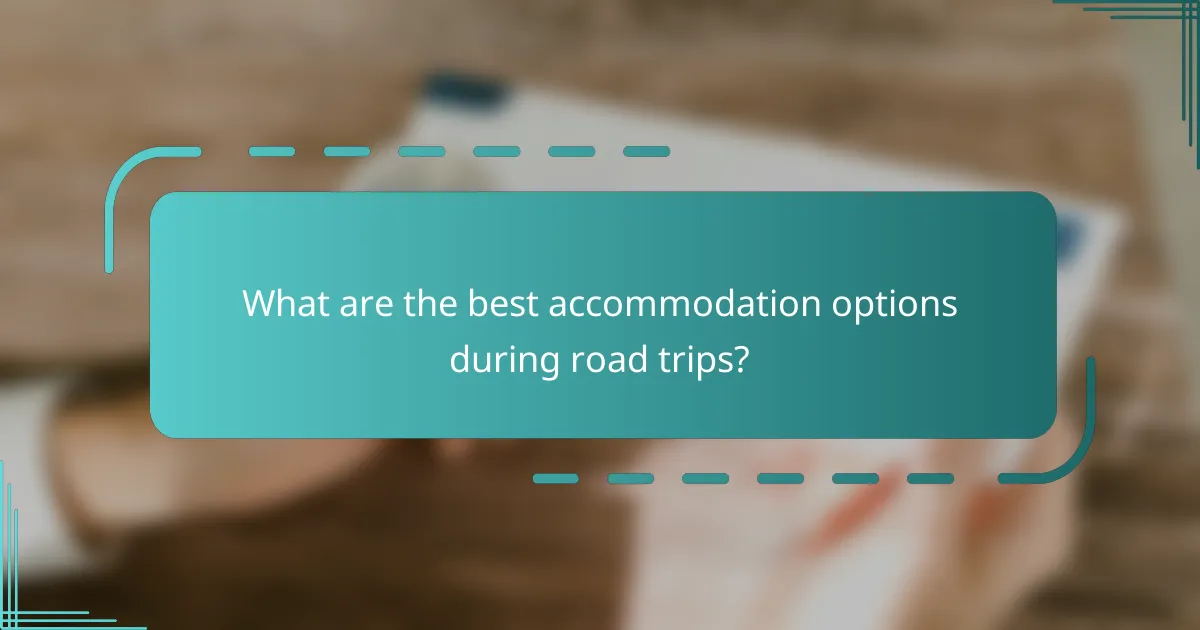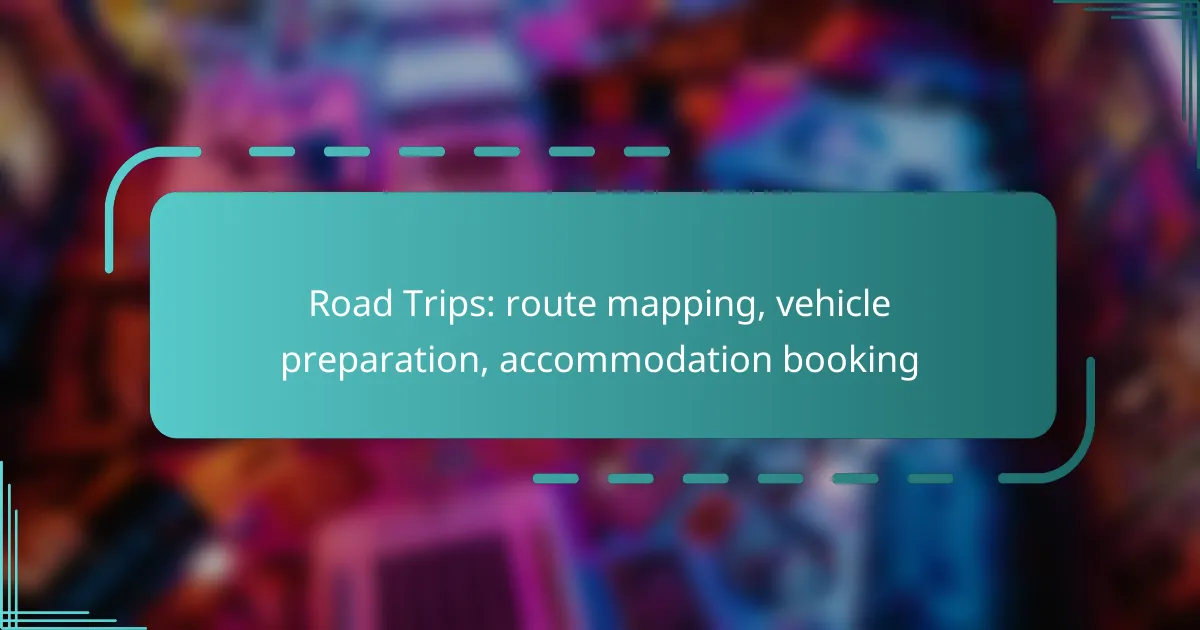Embarking on a road trip requires careful planning to ensure a memorable experience. From mapping out your route with ideal stops to selecting a comfortable and efficient vehicle, each detail contributes to a successful journey. Additionally, preparing your vehicle and securing accommodations ahead of time can help avoid unexpected challenges along the way.

How to plan a road trip route in the USA?
Planning a road trip route in the USA involves selecting your destinations, determining the best roads, and considering stops along the way. A well-thought-out route enhances the travel experience by balancing efficiency and enjoyment.
Using Google Maps for route planning
Google Maps is a powerful tool for planning road trip routes in the USA. You can enter multiple destinations, view estimated travel times, and explore different routes based on your preferences.
To optimize your route, use features like traffic updates, alternate routes, and the ability to avoid tolls or highways. Save your routes for easy access during your trip.
Best road trip apps like Roadtrippers
Apps like Roadtrippers are designed specifically for road trip planning, offering features such as points of interest, accommodations, and attractions along your route. These apps can help you discover hidden gems and plan your stops effectively.
Other popular road trip apps include Waze for real-time traffic updates and GasBuddy for finding the cheapest fuel along your journey. Each app has unique features, so consider your priorities when choosing one.
Popular scenic routes in the USA
The USA is home to numerous scenic routes that enhance the road trip experience. Notable examples include the Pacific Coast Highway in California, Route 66 stretching from Chicago to Santa Monica, and the Blue Ridge Parkway in the Appalachian Mountains.
Each of these routes offers stunning landscapes and opportunities for exploration. Researching these scenic drives can help you choose the best options for your trip based on your interests and time constraints.
Tips for optimizing travel time
To optimize travel time during your road trip, plan your driving hours to avoid peak traffic times. Early mornings or late evenings often provide smoother travel experiences.
Utilize apps that provide real-time traffic updates and adjust your route accordingly. Additionally, consider scheduling regular breaks to prevent fatigue and maintain focus on the road.

What vehicles are best for road trips?
The best vehicles for road trips are those that offer a balance of comfort, fuel efficiency, and space for passengers and luggage. SUVs and fuel-efficient cars are popular choices, as they provide ample room and can handle various terrains while maintaining good mileage.
Top SUVs for long-distance travel
When considering SUVs for long-distance travel, look for models that prioritize comfort and cargo space. Popular options include the Honda CR-V, Toyota RAV4, and Ford Explorer, which offer spacious interiors and advanced safety features.
These SUVs typically have higher seating positions, providing better visibility on the road. Additionally, many come equipped with infotainment systems that enhance the driving experience, making long hours on the road more enjoyable.
Best fuel-efficient cars for road trips
Fuel-efficient cars are ideal for road trips, especially for those looking to save on gas expenses. Models like the Toyota Prius, Honda Civic, and Hyundai Elantra are known for their impressive fuel economy, often achieving over 40 miles per gallon on the highway.
Choosing a fuel-efficient vehicle not only reduces costs but also minimizes environmental impact. When planning a road trip, consider how much driving you will do and calculate potential fuel savings based on your chosen vehicle’s efficiency.
Essential vehicle features for comfort
Comfort features are crucial for a pleasant road trip experience. Look for vehicles with spacious seating, adjustable seats, and climate control systems to ensure a comfortable ride for all passengers.
Additional features such as a good sound system, USB charging ports, and ample storage space for snacks and personal items can significantly enhance the journey. Consider test-driving vehicles to assess comfort levels before making a decision.

How to prepare your vehicle for a road trip?
Preparing your vehicle for a road trip involves checking essential components to ensure safety and reliability. Focus on tire health, fluid levels, and emergency supplies to avoid breakdowns and ensure a smooth journey.
Checking tire health and pressure
Start by inspecting your tires for any visible damage, such as cracks or bulges. Ensure that the tread depth is adequate, as worn tires can significantly affect traction and safety.
Next, check the tire pressure using a gauge. Proper inflation is crucial; refer to your vehicle’s manual for the recommended pressure, which typically ranges from 30 to 35 PSI. Under-inflated tires can lead to poor fuel efficiency and increased wear.
Essential fluids to check before departure
Before hitting the road, check the levels of essential fluids including engine oil, coolant, brake fluid, and windshield washer fluid. Each fluid plays a vital role in vehicle performance and safety.
For engine oil, ensure it is clean and at the proper level, as low oil can lead to engine damage. Coolant should be topped off to prevent overheating, especially during long drives. Aim to check these fluids regularly, ideally before every trip.
Emergency kit essentials for road trips
An emergency kit is crucial for any road trip, providing peace of mind in case of unexpected situations. Include items such as a first aid kit, flashlight, jumper cables, and basic tools.
Additionally, consider packing non-perishable snacks, water, and a blanket. These supplies can be invaluable if you encounter delays or breakdowns. Regularly review and replenish your emergency kit to ensure everything is in working order.

What are the best accommodation options during road trips?
The best accommodation options during road trips typically include camping, motels, and hotels, each offering unique benefits and drawbacks. Choosing the right option depends on your budget, comfort preferences, and the nature of your journey.
Camping vs. hotels: pros and cons
Camping can be a cost-effective and adventurous choice, allowing you to connect with nature and often enjoy scenic locations. However, it requires more preparation, such as packing gear and dealing with weather conditions.
Hotels provide convenience and comfort, often including amenities like Wi-Fi and breakfast. The downside is that they can be more expensive, especially in tourist-heavy areas. Weighing your priorities will help you decide which option suits your trip best.
Top-rated motels along popular routes
Motels are a popular choice for road trippers due to their affordability and convenient locations along highways. Some well-rated options include the Best Western and Motel 6 chains, which offer consistent quality and reasonable prices, typically ranging from $70 to $150 per night.
Additionally, local motels can provide unique experiences and personalized service. Researching reviews on platforms like TripAdvisor or Yelp can help you find the best-rated motels along your route.
Booking platforms for road trip accommodations
Several online platforms can simplify the process of booking accommodations for your road trip. Websites like Booking.com, Expedia, and Airbnb offer a wide range of options, from hotels to unique stays like cabins or RVs.
When using these platforms, filter results based on your budget, location, and desired amenities. It’s also wise to read recent reviews and check cancellation policies to avoid unexpected issues during your trip.

What are the costs associated with road trips?
The costs associated with road trips can vary significantly based on factors like vehicle type, fuel prices, accommodation choices, and travel distance. Understanding these costs helps in budgeting effectively for a smooth journey.
Fuel costs for various vehicle types
Fuel costs depend largely on the type of vehicle you drive. For instance, compact cars typically achieve better fuel efficiency, averaging around 30-40 miles per gallon, while larger SUVs may only get 15-25 miles per gallon. This difference can lead to substantial fuel expenses over long distances.
To estimate fuel costs, calculate the total distance of your trip and divide it by your vehicle’s miles per gallon rating. Then, multiply that figure by the current price of fuel per gallon. For example, if your trip is 1,000 miles, your compact car gets 35 mpg, and gas costs $3 per gallon, your fuel cost would be approximately $86.
Accommodation pricing trends across the USA
Accommodation prices in the USA can fluctuate based on location, season, and type of lodging. On average, budget hotels may charge between $70 and $150 per night, while mid-range hotels typically range from $150 to $250. In popular tourist areas, prices can be significantly higher, especially during peak seasons.
When booking accommodations, consider using online platforms that compare prices and offer user reviews. Booking in advance often yields better rates, and staying outside major cities can also reduce costs. Look for special deals or discounts, especially for extended stays, to maximize your budget.
